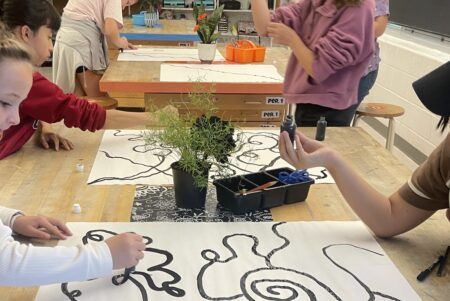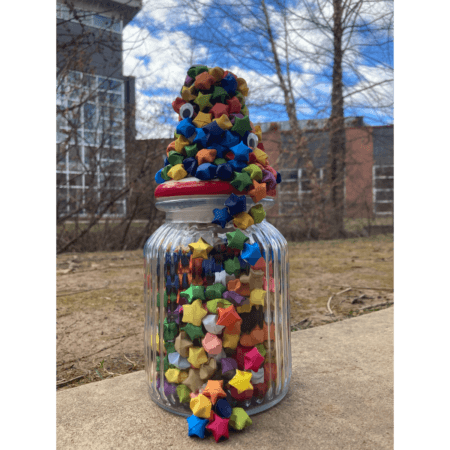Teaching with Contemporary Art
Begin Again

Courtesy of Mary Goldthwaite.
When my teaching practice feels stagnant, I find ways to begin again. The best professional development experiences that I have had as an educator have been scenarios that have thrust me into being a beginner. As you accrue more years at the helm of a classroom, it is easy to forget how vulnerable it is to be a learner in a new class.
Years ago, I took a very specialized realist drawing class that taught in a structure modeled after 19th century French academies. I was reminded of what it felt like to not automatically be able to draw just like the teacher, and it was excruciating. I returned home after the first night with a scatter plot of dots across the page, second-guessing every mark that I had made. The instructor had seen me quietly flailing alongside my easel and said, “At some point, you just need to make a mark.” Though my own way of teaching drawing is entirely different, taking this course made me rethink my approach. I intensified my emphasis on looking at something closely and normalizing a wide range of feelings (in the body, the mind, and the heart) that can occur in the process of drawing.
In the fall of 2023, I began my second year as an elementary art teacher in southwestern New Hampshire. I teach at a Title 1 Public School that is PreK–Grade 5. A beautiful aspect of this job is that I have the potential of working with students for up to seven consecutive years. This return to school felt special because so many familiar faces were returning to our studio. I began the year using anchors that Dana Joy Helwick, a fellow Art21 Educator, shared with me:
Body: When I am engaged in play, what does that feel like in my body?
Mind: How do I prioritize play in my work already?
Heart: How do I feel about my relationship to play?
I’ve been thinking about simple terms deeply: play, joy, love.
When was the last time you truly played?
Play naturally connects to process. The play of an artist is visible while an artwork is being made, and not necessarily in a finished product. Teachers are hard-pressed to take play seriously because it is culturally synonymous with wasting time. Educators have to address curriculum, standards, targets, and goals. The data needs to be measurable. The progress needs to be quantifiable. Play can feel taboo.
Body: When I am engaged in play, what does that feel like in my body?
I found myself as a beginner once again at the Art21 Educators Institute, where I participated in my first live TASK Party, which is a concept developed by Oliver Herring. TASK is an open structure where all are welcome to participate, and “everyone is a creative agent.”

Courtesy of Mary Goldthwaite.
I have been familiar with the concept of a TASK Party for a number of years but have never participated in nor led one in the classroom. I had some trepidation. In theater settings, I have a fear of audience participation. I felt self-conscious. My friend and colleague, Ari, must have sensed my anxiety and said, “Let’s choose a task together.” The slip of paper said, “Start a Whispering Club,” and so we did. We created badges and sashes out of colorful construction paper. We encouraged people to join our club and emphasized that we were very welcoming despite all the whispering. We constructed a makeshift clubhouse underneath a giant work table. I lay on the floor underneath the table with my head resting on the crossbar and I felt the most ease and silliness that my body has felt in months. I was truly present and calm. We laughed as more and more of our friends packed in like sardines.
Mind: How do I prioritize play in my work already?
After 15 years of teaching studio art to adolescents, I made the decision to move to the elementary level at the end of the 2022 school year. Up to that point I believed that my purpose was to show my students that art includes them, that they ARE ARTISTS, and that art defies definition. As I got to the elementary art studio I realized that I needed to reconceptualize my purpose as an educator. These young conduits of light already know that they are artists. They can’t imagine that anyone would think otherwise. This shift has been another way to begin again.
At the beginning of this school year I made a commitment to try to embody the ethos of one of my creative heroes, Corita Kent. She coined the term “PLORK” which is an amalgamation of the words play and work. I taught the concept to my 270 students. Our working definition is that to use the term PLORK is to emphasize that we take play seriously and bring joy to the work that we do in our shared creative space. There are visual reminders posted around the studio, and PLORK is emphasized at the end of each morning message. I have given a lot of lip service to my commitment to making space for play in our studio. Over the winter break, however, I realized we were not practicing the freedom of play with enough consistency. I had an internal battle with my perceived expectations from other adults. I assume that most people expect me to lead a more traditional discipline-based art classroom. Most people expect a beautiful result and focus less on the process. My gut feeling was that I needed to let go–of control, of set outcomes, and just let them play. My classes talked about the differences between the words play and competition. There was a consensus that play is open-ended, process-based, and without a set destination. There was also recognition that play can be robbed of joy when one participant tries to control too much of the process. I kept thinking of the TASK party of the summer, but was having a hard time diving in.
I felt that I needed a way to bridge the gap between a structured lesson where I was making most of the decisions in terms of inspiration, media, and process to making space for a TASK-like experience. I came up with an unfolding structure that would evolve over four sessions. I am currently halfway through the process.
- Introduction to Art Out of the Box: I picked up a game that I keep in the studio: Art Out of the Box, which is a tool for idea generation. There are 80 cards that are divided into two categories: subject and technique. As a class we defined both terms, and artists were given a card from each category to use as a prompt. They had the choice to use one card or both. They could work on their own or collaboratively. They could work small or large, and on many pieces or just one.
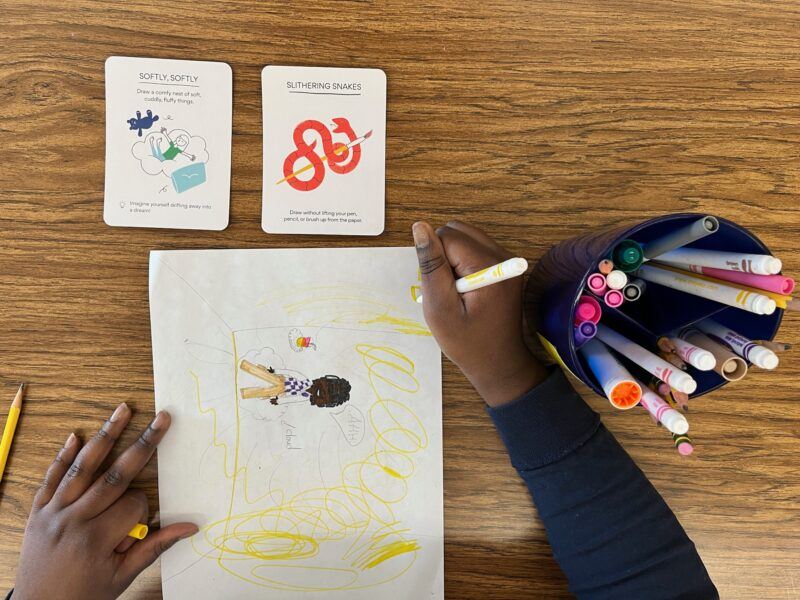
Courtesy of Mary Goldthwaite.
- Upon their next visit to the studio, Learners were Introduced to Oliver Herring’s Extended Play Film TASK and Develop Own Subject and Technique Prompts for The Art Out of the Box Game. I modeled drawing sketchnotes while we watched the film and discussed what we noticed and wondered about TASK. In every group someone asked excitedly, “Can we have a TASK party here?!?”
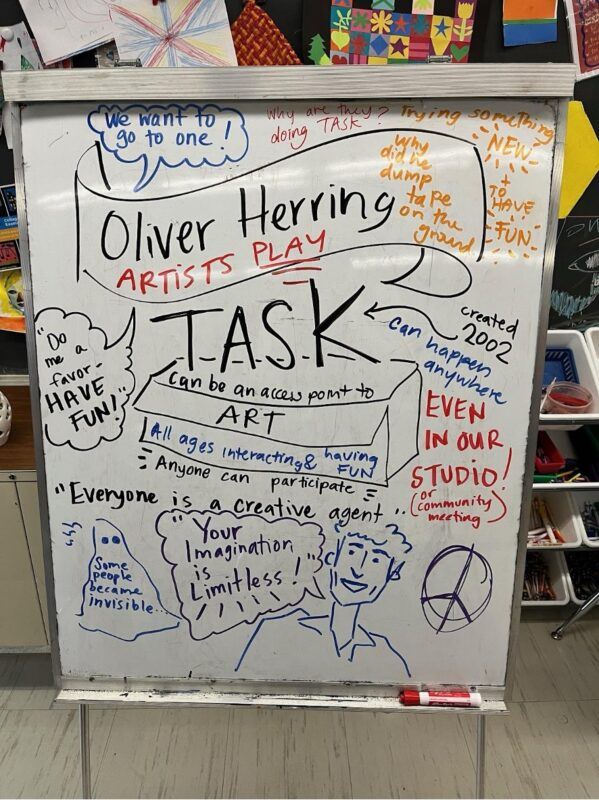
Courtesy of Mary Goldthwaite.
- The next time third through fifth grade artists enter the studio they will play their own version of the Art Out of the Box Game using the prompts that they have created.

Courtesy of Mary Goldthwaite.
- Throughout the school year learners and educators have been asked to think about their hopes and dreams for the school year. Our fourth class in this unit will fulfill my dream to center PLORK in the studio and host our first series of TASK Parties. We will expand beyond drawing prompts to more abstract tasks and artists will have access to more varied materials.We are having ongoing conversations about what it feels like to work in this way, and here are some young artist’s responses to the question, “What worked for you while playing (or PLORKing) in the studio?”:
“When I made a mistake, I felt like I could fix it really fast.”“As we played it got easier and easier to come up with ideas.”“It was easier to communicate as a group when we were working together.”
“The artwork changed over time.”
“It was really fun. I noticed laughter in the studio.”

Courtesy of Mary Goldthwaite.
Heart: How do I feel about my relationship to play?
I think of feelings as being connected to care. Anytime that I am making art I am chasing a feeling of total presence that I got as a child drawing Archie comic book characters at the end of my bed. It is a quieting of the mind and total attention to the moment. Presently, one of my many notes to myself at my desk says to “Be Where Your Feet Are.” In practice, as an educator, I find it even more difficult to stay in the moment and not be distracted by what is next. In the studio with my young artists I feel like I am on the right path, and that we have shared hopes and dreams.
What I have seen in the studio in recent weeks is our studio time looking, sounding, and feeling like it should on a consistent basis. I noticed that my students were writing text onto their drawings explaining their process without being prompted to do so. These young artists are taking play seriously and are joyfully engaged in their work. I see artists explaining their process and decision making. I am hearing new voices from artists who had previously been more hesitant.
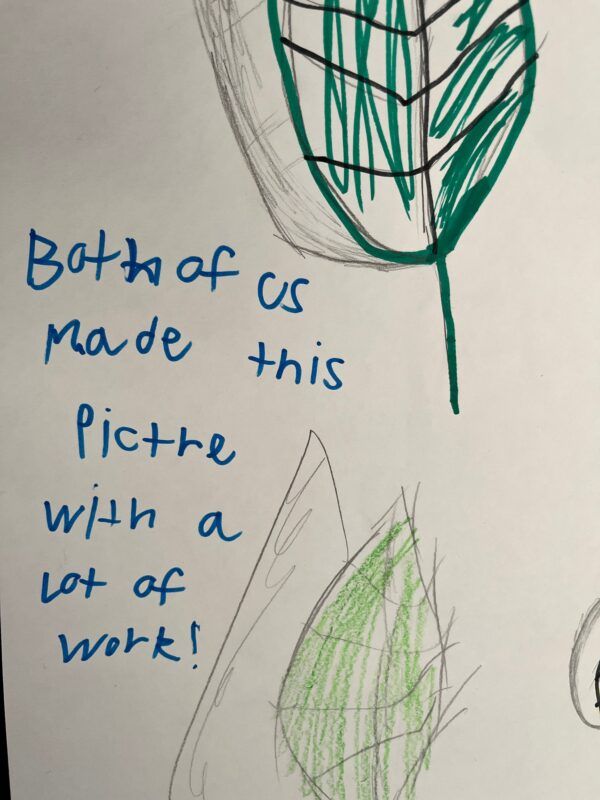
Courtesy of Mary Goldthwaite.
“Play gives children a chance to practice what they’re learning.” –Fred Rogers
Any point in the school year can be an opportunity to begin again and make space for more play, joy, and love in the shared studio. This exercise in letting go has sparked authentic student reflection, expanded collaboration, and has prioritized fun in the process.
“Work is often done by playing around.” –Corita Kent
Reading List
-
- Roxaboxen by Alice McLerran
- We All Play By Julie Flett
- Can I Play Too? By Mo Willems
- Make Meatballs Sing: The Life and Art of Corita Kent by Matthew Burgess
- Learning By Heart: Teaching to Free the Creative Spirit By Corita Kent and Jan Steward

